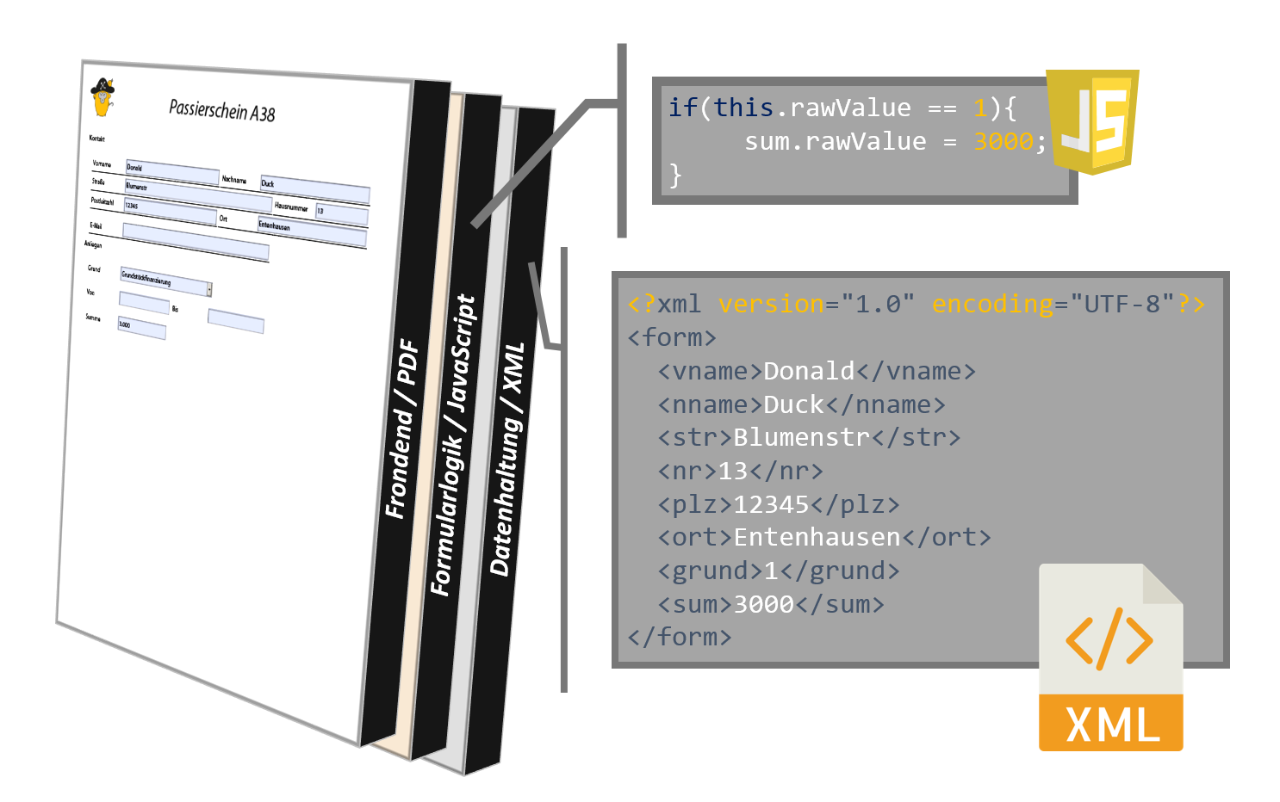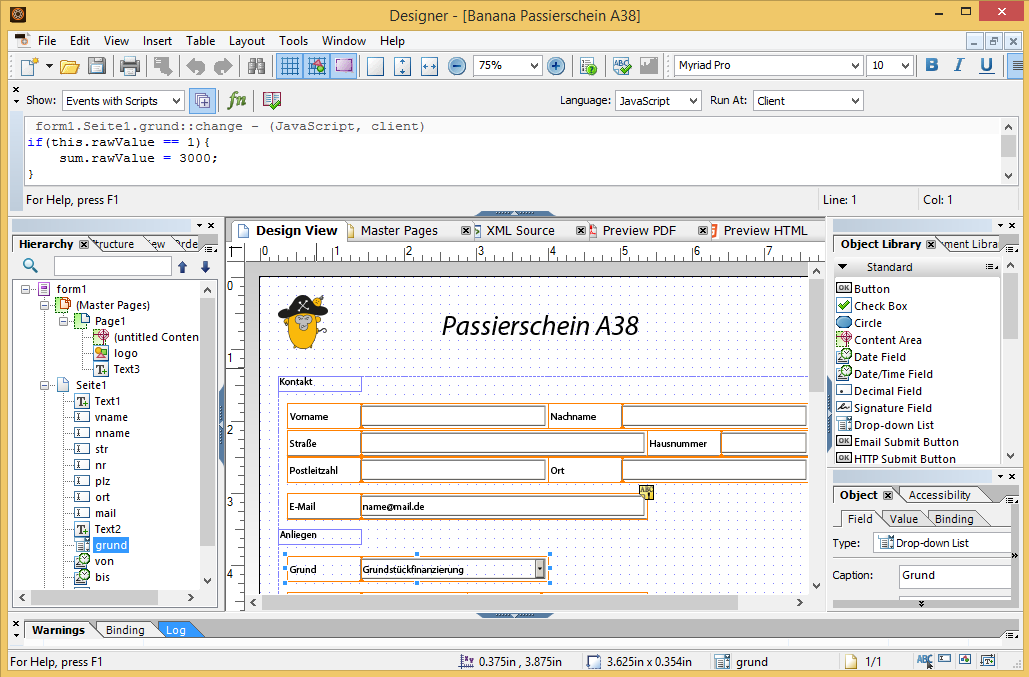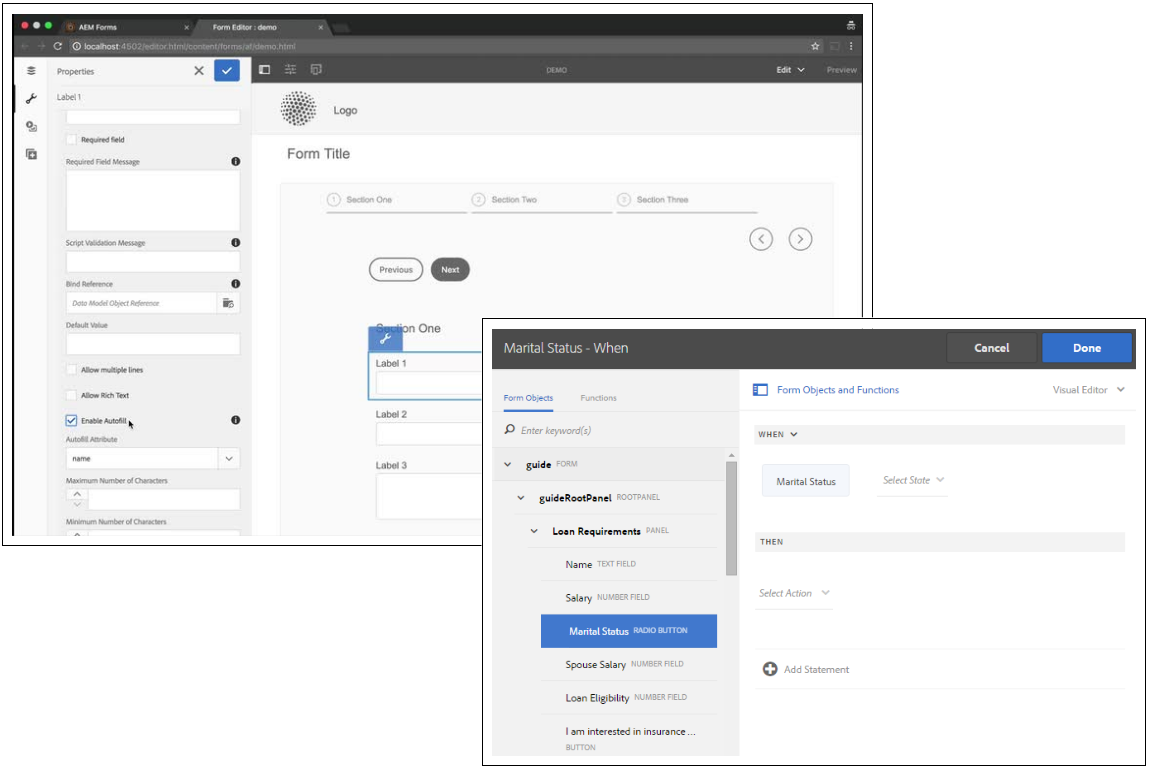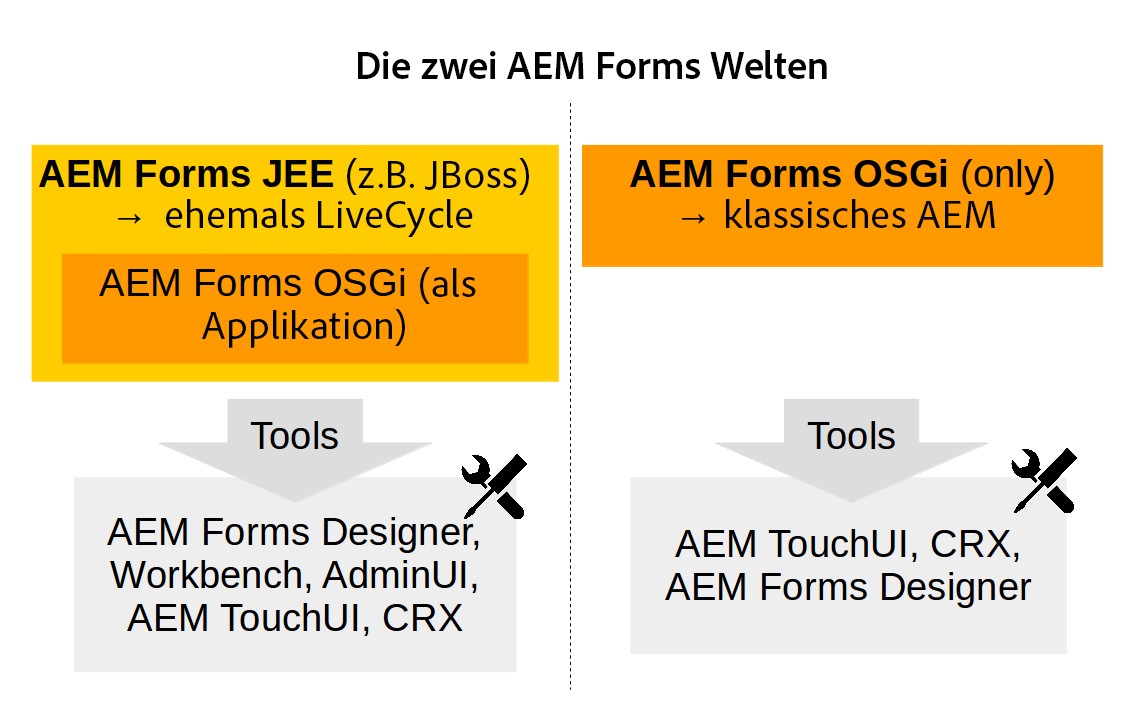
AEM forms from a developer's perspective
AEM Forms (formerly Adobe LiveCycle)
AEM Forms is a complete platform for collecting, managing and processing data in forms and documents based on various formats. With AEM Forms, internal and external processes can be made more efficient, customer oriented and data flow can be optimised. The solution includes a frontend for forms, a backend for processes, various document services and a variety of interfaces.
The Frontend
BACK IN THE DAYS: THE PDF FORM
Adobe is the founder of the Portable Document Format (PDF) standards and has shaped the topic of "digital forms" like no other company. A digital form has been synonymous with an Adobe PDF for years. The Adobe Reader as PDF Viewer was the defacto standard for displaying PDF documents. A PDF form could be much more than a flat, static and printable form. In 2004, Adobe created a new era in form display and form data processing with Adobe LiveCycle technology. With the introduction of the XFA standard (XML Forms Architecture), PDF forms could be provided with logics and validations using JavaScript or FormCalc. Due to the additional possible data transmission via XML (Extensible Markup Language), forms could be so extensively designed that they could come close to the correct utilisation. These PDF forms are called XDP forms.
With the AEM Forms Designer, the developer has the opportunity to use SOAP. This way, data can be retrieved at runtime via SOAP.
Today, the development of XDP forms is still done with the provided Adobe "Designer". The product name Adobe LiveCycle Designer is still very common and widely used, although the tool has been called AEM Forms Designer since 2015. With the AEM Forms Designer, you can create dynamic, interactive and intelligent PDF forms that can be adapted to a specific use and simply filled out by the user with Adobe Reader.


XFA forms offer powerful functionality, but there is one limitation: they only work in Adobe Reader. The mobile Adobe Reader app, as well as other PDF viewers, do not support the XFA format or only very rudimentarily.
With the proliferation of smartphones and tablets, the need for mobile forms to work on all devices and in all browsers has increased and they that are optimally displayed on all screen sizes.
Therefore, in 2014, Adobe decided to merge Adobe LiveCycle with its own Web Content Management system AEM (Adobe Experience Manager). Since AEM6.0, the Forms solution is now an integral part of AEM and now bears the name "AEM Forms" instead of "Adobe LiveCycle". With this technological move, Adobe took a big step toward web development of forms.
What does Acrobat actually offer in the area of forms?
Adobe Acrobat Pro also provides easy form-creation capabilities. However, these are based on the AcroForms technology and not on XFA. With AcroForms, you quickly discover its limitations within the corporate environment. For example, AcroForms do not provide the ability to bind form data to a schema and reuse XML data in such a predefined structure. The data transfer from and to interfaces (for data pre-filling, sending, or reloading when filling in) can therefore only be realised with increased effort and workload.
AEM Forms is responsive!
The CMS Adobe Experience Manager, extended by the Forms module, offers a comprehensive platform for the development of responsive HTML5 forms. With so-called "Adaptive Forms”, the developer now has all the possibilities of modern web technology available. This includes:
- HTML5, CSS, Less / Sass, JavaScript and numerous frameworks / libraries e.g. jQuery, Bootstrap, requireJS, Grunt, Bower, NodeJS
The forms front-end code can be integrated into existing development environments (such as IntelliJ or Eclipse), and tools such as Docker, Maven, and Git can be used in the development process
Creating and integrating logic in Adaptive Forms is no longer done in the AEM Forms Designer, but in a web interface from AEM Forms. This interface offers the author in the so-called "Rule Editor" an extensive portfolio of predefined logics, so that for a large part of the development, programming knowledge is not required. Forms are mainly created using drag & drop and configurations. If more complex rules or dependencies are required in forms, they can be extended using JavaScript (as in the AEM Forms Designer).
Data management in Adaptive Forms continues to use XML. Since version AEM6.3 Forms, there has been the additional possibility to use the JSON format.
Interfaces to third party systems are easy to use. Since version AEM6.2 Forms, they can be globally integrated in the Adaptive Forms as a data service and can be utilised by the form creator very simply and without an interface knowledge.

PDF is dead, long live PDF
The use of HTML forms are at first sight hindered by a number of possible obstacles:
- HTML forms can not be signed
- HTML forms can not be archived in an audit proof manner
- HTML forms can not be printed
Adobe has a solution for it. With AEM Forms, form data from an Adaptive Form can be returned to a PDF. This PDF can then be digitally signed, printed or archived. For the creation of this so-called "Document of Record" (DoR) Adobe offers the following possibilities:
1. Generic Document of Record: The DoR PDF is rendered based on the adaptive form, i.e. all correspondingly parameterised fields are transferred from the web form to the PDF. The styling of the fields happens once in an XDP template. The generic DoR template can be used for all web forms. The benefit of a generic DoR template is that it can be used with any number of forms.
2. XDP-based DoR: By binding the form fields of an Adaptive Form with a specific Designer XDP template (for example via an XML schema), the extracted data from the form can be returned to a PDF. However, redundant maintenance of the form is required because a Document of Record PDF prediction is created for each Adaptive Form. This approach is useful when e.g. from a marketing point of view, there are high design requirements for the DoR PDF, since each field in the DoR form can be individually graphically adjusted.
The Backend
Once the data has been collected in the frontend as XML, it can be further processed as part of workflows.
At this point, you have to distinguish between two technical characteristics of AEM forms:

AEM Forms JEE
On the Java platform from AEM Forms, the developer has a variety of functions at their disposal.
- Assembler: modification / information / extraction from PDF documents
- Output: merging of XML data sets and templates for the generation of PDF and print documents (Postscript / PCL / ZPL etc.) in a single or batch process; Conversion and validation of PDF / A documents
- Forms: merging of XML data sets and templates into fillable PDF forms and extraction/further processing of the contained data, application of dynamic 1D or 2D barcodes and their evaluation.
- PDF Generator: Conversion of various formats (images, MS Office etc.) into PDF and from PDF to various formats.
- Reader Extensions: enable PDF documents advanced features for Adobe Reader (such as embedding attachments, invoking web services, saving modified documents, etc.).
- Workflow: task assignments to users and user groups to capture data and decisions during ongoing processes; Web interface and mobile app for viewing and editing tasks; reminders, escalations, deadlines.
- Foundation Services: "Kitt" to enrich processes with data or pass data onto other systems: e.g. LDAP, database interface via JDBC, e-mail, SOAP client, XSLT, FTP, access to files etc.
- Document Security (Digital Rights Management): Dynamic rights management to restrict and track access to documents by assigned role.
- Digital Signatures: provide the possibility to have PDF documents with certificates (including qualified certificates) and thus enable a legally valid signature. Likewise, these can also be checked for validity.
- In addition to this extensive portfolio of existing process steps, there is also the option of integrating Java (so-called DSCs) programmed components into the process.
Architecture Overview
AEM Forms JEE follows the SOA approach in its architecture. All services can be accessed directly via an API. The provided tool "Workbench" offers the possibility to graphically merge and configure the activities - referring to the specification language BPMN - to workflows.
JBoss, WebSphere or Weblogic is used as an application server with a database (Oracle, MySQL or MSSQL).
AEM forms on OSGi
Thanks to the integration in AEM, AEM Forms can also be operated stand alone in the OSGi variant (without JEE server). This provides the developer with the workflow management system that AEM already supplies. Since AEM Forms6.3, all functions of the JEE platform have been integrated (with the exception of the Document Security). A task assignment (for example for approval steps) is also available here.
Most requirements can be implemented with this variant, so that the JEE workflow management system only has to be operated for particularly complex processes or for migration purposes.
Even if all OSGi services can be used in the JEE variant (AEM OSGi runs as mentioned in the JEE as an independent application), it is good to know which services the JEE is no longer necessary for and which technology this has been implemented in. These include, for example:
Even if all OSGi services can be used in the JEE variant (AEM OSGi runs as mentioned in the JEE as an independent application), it is good to know which services the JEE is no longer necessary for and which technology this has been implemented in. These include, for example:
Services for OSGi

Adobe Sign is a cloud based signature service that seamlessly integrates itself with adaptive forms. Depending on the legal requirements, the service offers different possibilities to sign the forms. Adobe Sign offers as a stand-alone platform and additionally, the possibility to carry out authorisations. Forms from the AEM world can easily be transferred here.

Many customers now prefer digital communication, but print and PDF are still important communication channels. For compliance reasons or for offline use cases. Therefore, Adobe has created a cross-channel solution for online, offline, PDF and printing: Interactive Communications. With this solution, specialist users work in a single user interface for creating, previewing and publishing documents that can be delivered to mobile devices using responsive design as well as being able to generate PDF / print versions of it.

A big issue in process management is the integration of third-party systems. AEM has offered an independent interface since version 6.3, in which many well-known technologies such as SOAP, REST, SQL and SharePoint etc. can be used. Once defined, form authors can easily integrate them into their form without having complete knowledge of the authentication or technology of the service. Your own personalised interfaces can be developed independently in OSGi.

Another cloud service that is now available is Adobe Analytics, which measures and evaluates the actual benefits of the forms. The web-based solution also now provides information on what causes problems when filling in the form. Thus, a much more extensive and accurate analysis can be performed.

In addition to the evaluation (Adobe Analytics), it is also possible to realise a controlled delivery of the forms via Adobe Target. This can be used, among other things to implement, A / B tests. Even personalized content can be controlled in an easy and goal-oriented way.
Summary
As a form solution, Adobe offers both the existing PDF and additionally, a worthy successor for form management. AEM Forms has the ability to "click together" many configurations in the interface. If a developer encounters any limitations here, they have many possibilities of web technology at their disposal. The differentiation between developers and form authors are clearer and their competencies can be expanded even more effectively.
